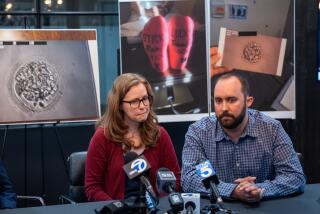Tardy Test-Tube ‘First’ Still Counts
- Share via
First there was the first test-tube baby.
Then there was the first test-tube baby conceived in Orange County.
Then there was the first test-tube baby born in Orange County.
Then Hoag Memorial Hospital Presbyterian in Newport Beach announced Friday that the first test-tube baby had been “born through an Orange County program.”
Oops. Make that the second. At least the second.
While Hoag was tooting its horn Friday, a few miles to the north in Buena Park, Ginger Canfield was feeding her daughter, Tessamarie.
Tessamarie finished the Test-Tube Baby Derby a good two months ahead of Hoag’s entry.
Yet on Friday, Hoag officials announced that Sharon Holz of Mission Viejo had given birth to 8-pound, 15-ounce Justin on July 22.
But Canfield had given birth to 9-pound, 4-ounce Tessamarie on May 13.
Both babies were conceived through the in-vitro fertilization method in Orange County--Justin at Hoag and Tessamarie at the Medical Center of Garden Grove.
Both babies were born in Orange County--at Hoag Hospital.
“We screwed up, and we screwed up bad,” said Gail Love, Hoag’s director of public relations.
According to Love, the boastful mistake was made by the hospital’s public relations department. A fact sheet containing the error was sent to Dr. Lawrence Werlin, who heads Hoag’s infertility clinic, and Werlin corrected it.
Nevertheless, the mistake made its way into the finished press announcement, thanks to a careless typist, Love said.
Werlin said that when he learned of the error, he promptly called Dr. Ricardo Asch, a prominent Orange County fertility specialist, and apologized.
Asch, who is affiliated with the UC Irvine Center for Reproductive Health, later told The Times, “I’m sure there are many more” test-tube babies bred and born in Orange County.
In fact, Asch said, “we have at least 50, all of them in Orange County.”
“The UCI program is the largest in the United States in volume of patients and perhaps one of the best in success rate” in in-vitro fertilization, Asch said.
As for Hoag, Werlin allowed, “I don’t know that it’s important to be the first in Orange County. . . . Our goal is to see our patients achieve a pregnancy.”
The commotion over who is first and who isn’t really is all but irrelevant to the major players in these real-life dramas.
Just ask Ginger Canfield, pregnant three times only to lose each child, one in a miscarriage and two through tubular pregnancies.
“We had discussed adoption. But in Orange County, for an infant it’s a long wait,” she said.
“I opened up the newspaper one day and saw Dr. Asch’s picture. I was one of the first people to come to UCI Medical Center when he got there.”
The in-vitro fertilization procedure--in which the mother’s eggs are placed in a laboratory dish and fertilized--worked for Canfield on the first attempt.
But Canfield, a grocery checker, and her husband, who works for United Parcel Service, had to pay the entire $7,000 bill because their insurance company did not cover the procedure.
“They don’t consider it a necessary surgery; it’s elective surgery,” she said. “But if you would see the women down there (and) the desperation they have, you would see it’s not something that I’d consider not necessary. To their mental outlook it is” necessary.
“There is something inside a lot of women that they want a family. You get to the point that you can’t even watch a Pampers commercial on TV without getting emotionally upset.”
As Sharon Holz held her new son, Justin, tightly in her arms at Hoag’s news conference Friday, she praised the hospital’s infertility clinic staff.
“This is the best family Justin could have been born to,” she said, looking at the staff members gathered around her.
Meanwhile, Asch said he is working with a U.S. Senate committee studying government regulation for clinics that perform in-vitro fertilization and other test-tube baby procedures.
“The main problem we have today is that there is no government regulation of any clinics that do (in-vitro fertilization) . . . in the United States,” he said. “Of the 150 clinics that do IVF . . . more than 50% have never had a pregnancy or delivered a child.”
Times staff writer Donn Walker contributed to this story.
More to Read
Sign up for Essential California
The most important California stories and recommendations in your inbox every morning.
You may occasionally receive promotional content from the Los Angeles Times.













